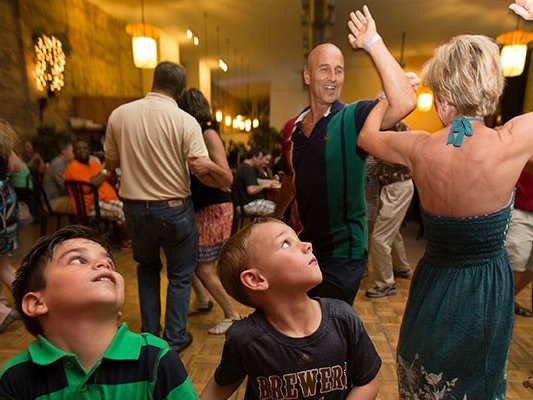Photographer Dick Blau is one who's self-taught. Not only does he have a B.A. from Harvard, he also has a PhD from Yale. After college, he had gone to SUNY Buffalo to help start the American Studies program as well as programs in Women's Studies, Native American Studies and Polish Studies in the late 1960s and early 1970s. He eventually moved to Milwaukee in 1975, where he then co-founded the Department of Film at UW-Milwaukee.
This is only part of what he's accomplished so far.
His insightful look into culturally rich polka music and dance – "Polka Heartland" – is currently on view at the Museum of Wisconsin Art. Following the 1992 book "Polka Happiness," which he had a hand in developing, the exhibit demolishes the false stereotype of polka being a dated art from. Instead, each of the 30 photographs on displays capture the ambience and energy of polka performances from around the state.
According to Blau, his involvement in the subject started by chance and design.
One day in the early 1970s, a colleague of his by the name of Charles Keil, a ethnomusicologist at SUNY-Buffalo in the American Studies department quoted jazz musician, Charles Mingus – "White Man, go study the polka!" – and vowed he was going to write a book on the subject.
"One weekend he went off to a polka dance and came back and said to me, 'You should check it out. It’s interesting."
The next time Keil went, Blau tagged along and brought his camera.
"He and his wife and I found our way out on a snowy night and we found our way through this parish and there were 500 people inside and I thought I had stepped inside a painting," Blau said. "I grew up in theater and improvisation so I was interested in the relationship of the performers, and dancers. This felt like it was showing the roots of theater in some way."
From that point forward, he was hooked on studying life and that’s what he got into photography for, to try to understand things about feeling and what’s genuine.
This almost unexpected interest and involvement in polka culture wasn't always as well-received as it is now.
"Basically in the ‘70s, when we started working on our first book, people would say, 'What are you doing?' I'd say, 'We’re writing a book on polka music,'" Blau said. "Their eyes would roll to the back of their heads. It was really considered like the corniest thing you could possibly do. When the accordion came back, people then understood why we were interested in polka music."
A couple of years ago, he got a call from Richard March who had said that he had a contract with Historical Press and asked if Blau wanted to work with him on developing "Polka Heartland" as a book.
"He set up the route and we basically went to these places," Blau said. "He looked at it as a musicologist, historian, and ethnographer. I looked at it as a photographer."
Reunited once again with his camera, he and March traveled to 25 different locations throughout the state, including three in Milwaukee, to capture the diversity of polka culture in the state.
"We made the book and then over the course of that, I contacted MOWA and said, 'How would you like to do a show on Polka music?' Lori Winters, who's the director of Museum, thought it was a great idea," Blau said.
For the book, he and March had to work out the relationship between pictures and texts. According to Blau, pictures are generally illustrations of the text, which is a "very dull way to look at pictures."
"I tried to really support both the text, but also give them independent life in the chapters," Blau said of the book. "I went to the museum and I realized what had to be done. There wasn’t a learning experience like the book. It was a feeling experience. I didn’t want to teach people anything I want them to feel something."
Blau did just that. He set out to make the exhibition that was really all about the feeling of the energy at these polka dances that he and March had visited.
"I was really interested in the feeling because what’s interesting about polka music to me was how people got together face-to-face and made a celebration together," Blau said. "You feel like the party just lifts off the ground. I learned something very important about human sociability. I was interested in celebratory gesture and how people naturally inhabit their gestures and joy."
With his camera in hand, he went about capturing this by simply engaging with those attending the dances. What was exciting to him was snapping pictures to make it as much of an immersive experience as possible when someone looks at the finished work.
"It's kind of an interesting, really weird experience because I don’t want music to be played in there," Blau said about the exhibit. "I try to convey the feeling, the memories of music. I’m trying to stimulate a whole bunch of senses at the same time. I’m trying to get people to imagine things. The sizes of the pictures will make you feel like you want to step into them."
Among the 30 photographs on display throughout the exhibit, there's a set of photographs that he took inside of an old, large building in Oregon, WI, that had an indoor soccer field and in the back of it was a Latin club, which had recently went under.
"It’s actually a huge thing," Blau said of Mexican polka. "It is much more mainstream in Mexican culture than Wisconsin polka is in Wisconsin culture. You feel like the whole thing is bubbling up around here and people don’t know about it. This band came up from Chicago and they were really good. It was a completely fascinating other world that you’d never imagine to be in Wisconsin. There was a smoke machine and this laser show and this band, dancers, and cowboy hats, boots and the whole thing."
Taking photographs in the Latin club that night, however, posed to be a problem. At other dances, such as the photographs of the Eastern European polka set, he felt like he could really interact with the people in attendance. In the Latin Club, however, was much different.
"We were welcome there and people were nice to us, but I didn’t feel like I could go up to people," Blau said. "I didn’t know the language. I felt like if I went up to someone, I would’ve gotten in the way of their dance. I shot it all from the side from the table. It took me hours to figure out how to shoot this thing because it was really dark, there was a smoke machine and there were these lasers going off. I was proud that I was finally able to it. I almost gave up on myself twice."
The positive aspect that came out of the experience was that he was able to capture images of Mexican polka, a culture that a lot of people don’t know about, according to Blau.
"They know about the other worlds of polka, but they don’t know about this," Blau said.
Although one would argue that polka is fading in contemporary culture, Blau said that is the opposite of the truth.
"Polka is still deeply embedded in certain ways," Blau said. "Not everybody does it, but enough people do it so it has indigenous authenticity to it. It doesn’t seem to be disappearing. I can tell you that. You can see it transforming in different ways. It’s kind of infectious."
"Polka Heartland: Photographs by Dick Blau" is running through March 29 inside of the Hyde Gallery at Museum of Wisconsin Art. For more information, go here.
Colton Dunham's passion for movies began back as far as he can remember. Before he reached double digits in age, he stayed up on Saturday nights and watched numerous classic horror movies with his grandfather. Eventually, he branched out to other genres and the passion grew to what it is today.
Only this time, he's writing about his response to each movie he sees, whether it's a review for a website, or a short, 140-character review on Twitter. When he's not inside of a movie theater, at home binge watching a television show, or bragging that he's a published author, he's pursuing to keep movies a huge part of his life, whether it's as a journalist/critic or, ahem, a screenwriter.







